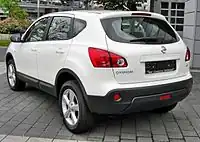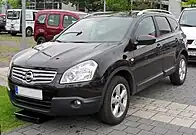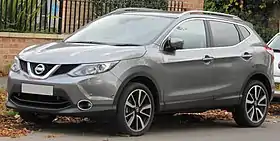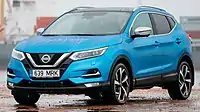Nissan Qashqai
The Nissan Qashqai (/ˈkæʃkaɪ/) is a compact crossover SUV (C-segment) developed and produced by the Japanese car manufacturer Nissan since 2006. The first generation of the vehicle was sold as the Nissan Dualis (Japanese: 日産・デュアリス, Hepburn: Nissan Dyuarisu) in Japan and Australia, and Qashqai in the rest of the world. The second generation, which was released in 2014, was not sold in Japan and was badged as the Qashqai in all countries it was sold, except in the United States, where it was rebadged as the Nissan Rogue Sport. The third and current generation was released in 2021.
| Nissan Qashqai | |
|---|---|
_IMG_4897.jpg.webp) | |
| Overview | |
| Manufacturer | Nissan |
| Also called | Nissan Dualis (Japan and Australia, 2006–2013) Nissan Rogue Sport (United States, 2017–2022) |
| Production | 2006–present |
| Body and chassis | |
| Class | Compact crossover SUV (C) |
| Body style | 5-door SUV |
| Layout | Front-engine, front-wheel-drive Front-engine, four-wheel-drive |
Nissan named the vehicle after the Qashqai people, who live in mountainous Central and Southwestern Iran.[1][2][3]
Development
When the Renault–Nissan Alliance was formed in 1999, Nissan's new COO Carlos Ghosn instructed the company to transform its product portfolio in Europe. The C-segment Almera, a slow-seller in Europe became a primary focus. In early 2002, 25 European Nissan engineers travelled to the brand’s technical centre in Japan to start of a 12-month project to develop the successor of the Almera. It was projected to be larger, to compete with the SEAT Altea and Volkswagen Golf Plus.
In December 2002, the company concluded the planned model would not be as profitable and competitive as was required. The development team eventually came up with the idea of a "mini-Murano" type of vehicle smaller than the X-Trail that would be positioned to compete with hatchback and saloons. The development was focused on creating a European-oriented vehicle with the desirability, practicality and versatility of an SUV but with the size, driving dynamics and running costs of a family hatchback. While engineering work was done by Nissan's European Technical Centre (NTCE), a design proposal was put forward by Nissan Design Europe (NDE), which created the 2004 Qashqai concept.
During final development, Nissan decided the Qashqai would serve as a replacement for both the Almera in the C-segment and Primera in the D-segment. Nissan selected Nissan Motor Manufacturing UK as its manufacturing plant for the European market.[4]
First generation (J10; 2006)
| First generation (J10) | |
|---|---|
 front view (pre-facelift) | |
| Overview | |
| Also called | Nissan Dualis (Japan and Australia) |
| Production | 2006–2013 |
| Assembly |
|
| Designer | Darryl Scriven, Masaki Aikawa and Patrick Reimer (pre-facelift)[5] |
| Body and chassis | |
| Platform | Renault–Nissan C platform |
| Related | Nissan Rogue (S35) Nissan X-Trail (T31) Venucia T70 |
| Powertrain | |
| Engine | |
| Transmission | 5-speed manual 6-speed manual 6-speed automatic CVT |
| Dimensions | |
| Wheelbase | 2,630 mm (103.5 in) 2,760 mm (108.7 in) (Qashqai+2) |
| Length | 4,315 mm (169.9 in) 4,535 mm (178.5 in) (Qashqai+2) |
| Width | 1,785 mm (70.3 in) |
| Height | 1,605 mm (63.2 in) |
| Chronology | |
| Successor | Nissan Juke (Dualis, Japan) Nissan X-Trail (Qashqai+2) |
First unveiled as a concept vehicle at the 2004 Geneva Motor Show, the first-generation Qashqai was globally presented at the 2006 Paris Motor Show. It went on sale in February 2007, and Nissan aimed for more than 100,000 sales a year. Codenamed P32L,[6] Nissan said the car would cater to buyers who want a more dynamic design, but are not attracted to the large, traditionally upright nature of an SUV. The car slots below the X-Trail in the Nissan range and partially replaces the conventional Primera and the smaller Almera.[4] It is the first model to be styled by Nissan Design Europe in London, with engineering development led by Nissan Technical Centre Europe (NTCE) in Cranfield, Bedfordshire.
The Qashqai uses the same platform as the X-Trail. It received a five star Euro NCAP safety rating – the best ever adult occupant score.[7]
Five engine choices were available: a 114 PS (84 kW; 112 bhp) 1.6 L or a 141 PS (104 kW; 139 bhp) 2.0 L petrol, while the 106 PS (78 kW; 105 bhp) 1.5 L, 130 PS (96 kW; 128 bhp) 1.6 L and 150 PS (110 kW; 148 bhp) 2.0 L provide the diesel offerings.
The first-generation Qashqai sold more than 1.24 million units in Europe during its seven year production run.[8] From the UK, the first-generation Qashqai was also exported to the Middle East and other overseas markets.
 Rear view
Rear view Interior
Interior
Name
Nissan considered releasing the Chinese version as the CCUV (Compact Crossover Utility Vehicle). In Australia, the first-generation Qashqai carries the name Dualis from the Japanese market because Nissan worried Qashqai could be pronounced "cash cow".[9] The press has often used that pun to describe the sales success of the model.[10][11]
Production
The Qashqai has been built at the Nissan Motor Manufacturing UK (NMUK) plant in Sunderland, Tyne and Wear, United Kingdom, since December 2006.[12] It occupied the production line previously used to assemble the Primera on Line 1 and a percentage of Almera from line 2.
Qashqai+2 (NJ10)
Production of the Qashqai+2, a seven-seat model, began at the UK plant in July 2008. Launched in October 2008, it is a larger variant of the standard model, with the wheelbase extended by 135 mm (5.3 in). The car's overall length is extended by 211 mm (8.3 in) to allow for a third row of seats, and roof height is increased by 38 mm (1.5 in) at the rear. The chassis is unique from the A-pillar back, while trim and engine models remain identical to the standard Qashqai.
The Qashqai+2 was discontinued in 2013, and replaced by the T32 X-Trail with a seven-seat configuration.
 Nissan Qashqai+2 (pre-facelift)
Nissan Qashqai+2 (pre-facelift) Nissan Qashqai+2 (pre-facelift)
Nissan Qashqai+2 (pre-facelift)
2009 facelift
In December 2009, Nissan announced a refreshed version of the first-generation Qashqai, which went on sale in March 2010. The model's front end has been completely restyled, while the rear now includes LED tail lights. Modifications to the interior include a new instrument panel layout for the vehicle's drive computer, better soundproofing and minor storage additions.
In the European market, electronic stability control became standard across the range and two new exterior colours have been added. An "eco-friendly" Pure Drive variant was also introduced.[13][14]
_Ti_wagon_(2015-07-03)_01_(cropped).jpg.webp) Nissan Dualis (facelift)
Nissan Dualis (facelift)_Ti_wagon_(2015-07-03)_02_(cropped).jpg.webp) Nissan Dualis (facelift)
Nissan Dualis (facelift)_%E2%80%93_Frontansicht%252C_8._Juli_2012%252C_Ratingen.jpg.webp) Nissan Qashqai+2 (facelift)
Nissan Qashqai+2 (facelift)_%E2%80%93_Heckansicht%252C_8._Juli_2012%252C_Ratingen.jpg.webp) Nissan Qashqai+2 (facelift)
Nissan Qashqai+2 (facelift)
2011 engine update
A new 1.6 dCi engine replaces the previous 2.0 dCi. Peak power was down from 110 kW (148 bhp; 150 PS) to 96 kW (129 bhp; 131 PS), but there is the same 320 N⋅m (240 lb⋅ft) of torque, available at 1750 rpm, rather than 2000 rpm. Nissan has not released full performance figures, but says the 1.6 dCi has a quicker 50–80 km/h (31–50 mph) acceleration figure than the 2.0 dCi.
Nissan has also added its Around View Monitor as standard equipment for 360 (replaces N-tec) versions of the Qashqai and Qashqai+2. The system uses a set of external cameras to create a 360 degree "bird's eye" view of the car to help with parking manoeuvres. The driver can also focus individually on front, rear or passenger cameras to look out for a particular obstacle.
Japan

The Japanese domestic market Dualis was offered in 2.0 G, 2.0 S, 2.0 G Four, and 2.0 S Four trim levels. All models are powered by 2.0-litre MR20DE engine matched to six-speed Xtronic CVT. The Dualis was discontinued in Japan on 31 March 2014, after which the Juke was the only Nissan's mini SUV still produced and sold in Japan.
Middle East
In some Middle Eastern markets, the first-generation Qashqai was offered in S, SE and LE, Standard on all trims is the 2.0-litre 106 kW (142 bhp) MR20DE engine with CVT.[15]
New Zealand
The Qashqai was introduced to New Zealand in May 2009, initially sourced from Japan. Nissan New Zealand used the Qashqai name to distinguish the model from Dualis grey imports, which were shipped from Japan before the official release. The New Zealand spec Qashqai was then sourced from the UK plant from August 2009. As of 2016 the range consisted of three specification levels: ST, ST-L and Ti, all with 2WD 2.0L MR20DE CVT. A TS model (1.6 diesel) was also available. The Qashqai+2 was added to the range in July 2010 but discontinued with the new model launch in 2014. The updated X-Trail (Rogue in United States), released at about the same time, became the only seven-seater option.
United Kingdom
The Qashqai has been made at the plant in Sunderland, England, since December 2006, occupying the production line previously occupied by the Nissan Primera on Line 1 and a percentage of Almera from line 2. Its launch coincided with the withdrawal of the Primera from the UK market due to low sales. This left Nissan with no direct successor to the Almera or Primera on the UK market, with the "supermini MPV" Note being sold as an indirect successor to the Almera, and the Qashqai as a successor to the Primera. This move was seen as controversial, but in time appears to have paid off as the Qashqai has proved a major sales success in the UK, with more than 39,000 sales in 2010 making it the tenth best selling new car in Britain – the first Nissan to make the top ten in Britain since the Sunny in 1983.[16] In 2010, Nissan was considering whether to introduce the Nissan Tiida to Europe,[17] it having already directly replaced the Almera in other markets. In 2012, the Qashqai's sixth year on sale in the UK, sales exceeded 45,000 to make it the sixth best selling car there that year.[18]
Russia
The Qashqai and Qashqai+2 (seven seat version) were available in Russia with the following gasoline powered four-cylinder engines:
For Qashqai
- 1.6 L — 85 kW (114 hp) 2WD; 5MT and CVT
- 2.0 L — 105 kW (141 hp) 2WD and 4WD; 6MT and CVT
For Qashqai+2
- 1.6 L — 85 kW (114 hp) 2WD; 5MT
- 2.0 L — 105 kW (141 hp) 2WD with 6MT only; 4WD with 6MT or CVT
Second generation (J11; 2013)
| Second generation (J11) | |
|---|---|
 2017 Nissan Qashqai Tekna (UK; pre-facelift) | |
| Overview | |
| Also called | Nissan Rogue Sport (United States) |
| Production | 2013–2021 (Europe) 2015–2023 (China) 2017–present (Japan and Singapore) 2019–2022 (Russia) |
| Assembly |
|
| Body and chassis | |
| Platform | Renault–Nissan CMF-CD platform |
| Related | Nissan X-Trail/Rogue (T32) Nissan Pulsar (C13) Renault Kadjar |
| Powertrain | |
| Engine | |
| Transmission | |
| Dimensions | |
| Wheelbase | 2,646 mm (104.2 in) |
| Length | 4,370–4,394 mm (172.0–173.0 in) |
| Width | 1,800–1,806 mm (70.9–71.1 in) |
| Height | 1,590–1,595 mm (62.6–62.8 in) |
| Chronology | |
| Predecessor | Nissan Rogue Select (for North America) |
The Qashqai J11 was introduced in London on 7 November 2013 at a worldwide streamed launch. The vehicle is larger and based on an all-new CMF-CD platform shared with the Nissan X-Trail/Rogue and Renault Kadjar. It went on sale in the UK in February 2014. The Qashqai J11 was awarded What Car? "Car of the Year" 2014.
The Dualis nameplate has been discontinued in Japan, as the second generation Qashqai is not sold there. At the time, Nissan Japan instead offers the smaller Juke, and the third-generation X-Trail.
The first generation model with the Dualis nameplate was sold alongside the newer model, which has borne the Qashqai name in Australia since July 2014.
Globally, it was available in 1.6-litre petrol and turbo-diesel engines, 1.5-litre turbo-diesel, 1.2-litre petrol turbocharged engine and 2.0-litre petrol engine.[21][22]
In September 2015, Nissan rolled a record-breaking 500,000th Qashqai off the production line at the UK plant, the fastest time for a vehicle built in the UK to reach a half million units.[23]
_%E2%80%93_Heckansicht%252C_24._August_2014%252C_D%C3%BCsseldorf.jpg.webp) Rear view
Rear view Interior
Interior
Facelift
On 27 October 2016, Nissan announced that the facelifted Qashqai J11 would be produced at the UK plant.[24] The facelifted Qashqai was unveiled at the 2017 Geneva Motor Show. The facelift version only went on sale in the United States (as the Nissan Rogue Sport) beginning with the 2020 model year.
 2017 Nissan Qashqai (facelift)
2017 Nissan Qashqai (facelift).jpg.webp) 2017 Nissan Qashqai (facelift)
2017 Nissan Qashqai (facelift) Interior (facelift)
Interior (facelift)
North America
In July 2015, Nissan announced a smaller counterpart of the Rogue to be marketed in North America.[25] At the 2017 North American International Auto Show in Detroit, Michigan, Nissan revealed the North American version of the Qashqai to slot between the Juke and the Rogue. For the U.S, it was known as the Rogue Sport to tie it in with the popular Rogue nameplate.[26] In Canada, the Qashqai kept its original name.[26]
Priced below the Rogue, the Rogue Sport replaces the Rogue Select, a version of the first-generation Nissan Rogue which has been discontinued from Nissan's lineup in the United States since 2015. The Rogue Sport went on sale in the United States in the spring of 2017 for the 2017 model year.[27]
Due to the significant differences in regulation between the U.S. and Europe, Nissan's UK plant did not produce the Rogue Sport. Instead, the North American market Rogue Sport/Qashqai were sourced from Japan.[28]
The US-market Rogue Sport and Canadian Qashqai is powered by a 2.0-litre, 141 hp (143 PS; 105 kW) inline-four petrol engine paired with CVT. It was offered in three trim levels, which consists of S, SV, and SL. Both front-wheel-drive and all-wheel-drive was offered.
For the 2020 model year, the US-market Rogue Sport and Canadian Qashqai got a refresh with a new front bumper cover and hood, new headlights and tail lights along with new alloy wheels. It went on sale in the fall of 2019.
Production of the Rogue Sport ended in December 2022, making 2022 the final model year for the US. In Canada, the Qashqai continues to the 2023 model year.[29]
 2017 Nissan Rogue Sport S AWD (US; pre-facelift)
2017 Nissan Rogue Sport S AWD (US; pre-facelift) 2017 Nissan Rogue Sport S AWD (US; pre-facelift)
2017 Nissan Rogue Sport S AWD (US; pre-facelift)%252C_front_10.10.20.jpg.webp) 2020 Nissan Rogue Sport SV AWD (US; facelift)
2020 Nissan Rogue Sport SV AWD (US; facelift)%252C_rear_10.10.20.jpg.webp) 2020 Nissan Rogue Sport SV AWD (US; facelift)
2020 Nissan Rogue Sport SV AWD (US; facelift)
China
Dongfeng Nissan started marketing locally produced Qashqai in the Chinese market since 2015.[30] Engine options available were 1.2-litre turbocharged petrol and 2.0-litre naturally aspirated petrol. All models are mated with Nissan's Xtronic CVT, except for the base 1.2-litre turbo variant which is mated with a six-speed manual gearbox.
Russia
Since 2014, the second-generation Qashqai was assembled in Nissan's Russian plant in Saint Petersburg in order to free up some production capacity in the UK plant and avoid import tariffs.[31] Nissan stopped assembling Qashqai at their St. Petersburg plant from March 2022 and went on to exit the Russian market entirely, selling its factory for 1 Euro.[32]
Powertrain
| Model | Year(s) | Displacement | Power | Torque | 0-100 km/h (0-62 mph) | CO2 emissions |
|---|---|---|---|---|---|---|
| Petrol engines[33] | ||||||
| 1.3i DIG-T 4X2
HR13DDT DCT |
2018- | 1,332 cc (81.3 cu in) | 159 PS (117 kW; 157 bhp) | 270 N⋅m (199 ft⋅lbf) | 10.2 s | 162 g/km (WLTP) |
| 1.3i DIG-T 4X2
HR13DDT |
2018- | 1,332 cc (81.3 cu in) | 159 PS (117 kW; 157 bhp) | 260 N⋅m (192 ft⋅lbf) | 10.2 s | 162 g/km (WLTP) |
| 1.2i DIG-T 4X2
HR12DDT |
2013– | 1,199 cc (73.2 cu in) | 116 PS (85 kW; 114 bhp) | 190 N⋅m (140 ft⋅lbf) | 10.6 s | 129 g/km |
| 1.2i DIG-T 4X2 XTRONIC | 2014– | 1,199 cc (73.2 cu in) | 116 PS (85 kW; 114 bhp) | 165 N⋅m (122 ft⋅lbf) | 12.9 s | 129 g/km |
| 1.6i DIG-T 4X2
MR16DDT |
2014– | 1,618 cc (98.7 cu in) | 163 PS (120 kW; 161 bhp) | 240 N⋅m (177 ft⋅lbf) | 9.1 s | 134 g/km |
| MR20DE | 2009-2013 | 1,997 cc (121.9 cu in) | 140 PS (103 kW; 138 bhp) | 200 N⋅m (148 ft⋅lbf) | 10.53 s | - g/km |
| MR20DD | 2014- | 1,997 cc (121.9 cu in) | 147 PS (108 kW; 145 bhp) | 201 N⋅m (148 ft⋅lbf) | ? | - g/km |
| Diesel engines[33] | ||||||
| 1.5 dCi 4X2 | 2013– | 1,461 cc (89.2 cu in) | 110 PS (81 kW; 108 bhp) | 260 N⋅m (192 ft⋅lbf) | 11.9 s | 99 g/km |
| 1.6 dCi 4X2 | 2013– | 1,598 cc (97.5 cu in) | 130 PS (96 kW; 128 bhp) | 320 N⋅m (236 ft⋅lbf) | 9.9 s | 115 g/km |
| 1.6 dCi 4X2 XTRONIC | 2013– | 1,598 cc (97.5 cu in) | 130 PS (96 kW; 128 bhp) | 320 N⋅m (236 ft⋅lbf) | 11.1 s | 119 g/km |
| 1.6 dCi All Mode 4X4-i | 2013– | 1,598 cc (97.5 cu in) | 130 PS (96 kW; 128 bhp) | 320 N⋅m (236 ft⋅lbf) | 10.5 s | 129 g/km |
| 1.7 dCi All Mode 4X4-i | 2019-2020 | 1,749 cc (106.7 cu in) | 150 PS (110 kW; 148 bhp) | 340 N⋅m (251 ft⋅lbf) | 11.2 s | |
Diesel emission problem
In May 2016, South Korea's environment ministry alleged Nissan used a so-called defeat device in Qashqai with diesel engines to turn off its exhaust reduction system under regular driving temperatures. It fined Nissan and ordered a recall of models with Euro 6 engines.[34][35] Nissan tried to sue the South Korean government but lost the court case.[36] The South Korean regulator tested the emissions of 20 diesel vehicles after the VW diesel scandal and found the Qashqai to be the only one that failed the tests.[36]
In the UK, the Qashqai diesel model was found to emit up to 18 times more nitrogen oxides than the official EU lab-based test allowed.[37]
Third generation (J12; 2021)
| Third generation (J12) | |
|---|---|
 Nissan Qashqai e-Power | |
| Overview | |
| Production | 2021–present |
| Assembly |
|
| Body and chassis | |
| Platform | Renault–Nissan CMF-CD platform |
| Related | |
| Powertrain | |
| Engine | |
| Electric motor | 12V electric motor/generator micro-hybridization solution (MHEV) AC3 synchronous (e-Power) |
| Power output |
|
| Transmission | |
| Hybrid drivetrain | Mild hybrid (1.3L 12V ALiS) Series hybrid (e-Power) |
| Battery | 12-volt advanced lithium-ion battery system (ALiS) 2 kWh Panasonic lithium-ion (e-Power) |
| Dimensions | |
| Wheelbase | 2,666 mm (105.0 in) |
| Length | 4,425 mm (174.2 in) |
| Width | 1,838 mm (72.4 in) |
| Height | 1,635 mm (64.4 in) |
The third-generation Qashqai was revealed on 18 February 2021.[38][39][40] The vehicle is slightly larger than before, being 35 mm (1.4 in) longer, 32 mm (1.3 in) wider and 25 mm (1.0 in) taller, while its wheelbase is 20 mm (0.8 in) longer,[41] and based on the CMF-CD platform shared with the Nissan Rogue/X-Trail (T33) and Renault Austral.
It is claimed to use more lightweight materials and advanced stamping and welding techniques in its construction to increase strength and reduce weight. The bonnet, front fenders and doors are made of aluminium and are 21 kg (46 lb) lighter, while the tailgate is made from composites and saves 2.3 kg (5.1 lb).[42]
For better visibility, Nissan engineered a thinner A-pillar design and the mounting of the wing mirrors on the doors instead of the A-pillar. Rear knee room for passengers has grown by 28 mm (1.1 in) to 608 mm (23.9 in), while headroom has increased by 15 mm (0.6 in). The boot is also 50 litres larger due to the lower cargo floor and redesigned suspension.[43]
The base engine option is the mild hybrid 1.3-litre four-cylinder DIG-T turbocharged petrol engine which makes 138 hp (140 PS; 103 kW) at 5500 rpm with 220 N⋅m (162 lbf⋅ft) at 1500–3500 rpm and 157 hp (159 PS; 117 kW) with 270 N⋅m (199 lbf⋅ft) at 1800–3500 rpm. It is paired to either a 6-speed manual or an Xtronic CVT transmission. All-wheel-drive is available for the 156 hp option with CVT.
For the first time, the Qashqai range also includes the e-Power hybrid powertrain. The system uses the ICE engine as a generator of electricity and disconnected to the driven wheels. The system combines a 154 hp (156 PS; 115 kW) 1.5-liter variable-compression petrol engine with a 187 hp (190 PS; 139 kW) electric motor, a power generator, and an inverter, making it a series hybrid with no plug-in capability.
 Rear view
Rear view_Auto_Zuerich_2021_IMG_0487.jpg.webp) Interior
Interior
Sales
| Year | Europe[lower-roman 1] [45] | Turkey | Canada[46] | China[47] |
|---|---|---|---|---|
| 2006 | 54 | |||
| 2007 | 89,919 | |||
| 2008 | 144,879 | 23,772 | ||
| 2009 | 180,468 | 33,877 | ||
| 2010 | 207,077 | 62,075 | ||
| 2011 | 208,649 | 111,304 | ||
| 2012 | 207,515 | 105,143 | ||
| 2013 | 201,722 | 124,589 | ||
| 2014 | 202,914 | 87,448 | ||
| 2015 | 230,661 | 60,072 | ||
| 2016 | 233,496 | 139,684 | ||
| 2017 | 247,199 | 8,970 | 156,322 | |
| 2018 | 229,382 | 19,662 | 175,045 | |
| 2019 | 218,946 | 18,526 | 179,773 | |
| 2020 | 135,829 | 11,074 | 161,193 | |
| 2021 | 113,276 | 11,973 | 156,890 | |
| 2022 | 116,365 | 5,449[48] | 10,631 |
- Europe: 2020 EU 27 + UK + Switzerland + Norway + Iceland
Nissan does not provide exact sales figures for the Rogue Sport in the US, instead grouping them together with the Rogue.
References
- "The Theory Of Naming A Car And The Nissan Qashqai". Nissan South Africa. May 7, 2020.
- Kidd, Kimiko (April 23, 2020). "How Did the Nissan Qashqai Get Its Name?". The Newswheel.
- "What does "Qashqai" mean?". Go Nissan. Edmonton, AB. September 25, 2019. Archived from the original on January 21, 2021.
- "The Qashqai story: necessity is the mother of innovation". Official Europe Newsroom. 2017-01-30. Retrieved 2022-02-07.
- "A00200603779". DGIP.go.id. Pangkalan Data Kekayaan Intelektual. 2007-01-05. Retrieved 2022-06-10.
- "NISSAN ANNOUNCES NEW MODEL FOR SUNDERLAND PLANT". Official Europe Newsroom. 2005-02-01. Retrieved 2021-12-22.
- "Nissan Dualis". Wheels Magazine. July 2007. p. 121.
- "NISSAN QASHQAI REVIEWS | 2014 – 2019 - Vehicle Reviews Tauranga". 2019-08-09. Retrieved 2023-01-24.
- "Qashqai nicknamed the "cash-cow"". 4 October 2006. Archived from the original on 2020-07-08. Retrieved 2012-06-12.
- "Nissan Qashqai "plus 2": Cashcow in der Verlängerung" [Nissan Qashqai Plus 2: Extended Cash Cow]. Die Presse (in German). Styria Media Group AG. 10 October 2008. Archived from the original on 2016-10-09.
- Love, Martin (26 October 2014). "Nissan Qashqai: car review". The Guardian. Archived from the original on 2015-12-12.
- "Qashqai Goes On Production". Euro Auto Trends. 5 December 2006. Archived from the original on 28 September 2007. Retrieved 2007-10-18.
- "Fresh Qashqai shows face". Auto Express. 2009-12-09. Retrieved 2011-09-13.
- "Nissan Press Office: Nissan Qashqai Crossover Updated for 2010". Nissanpress.co.uk. Archived from the original on 2009-12-08. Retrieved 2011-09-13.
- "Nissan Qashqai | Nissan". Nissan-ME.com. Archived from the original on 2016-10-08. Retrieved 2014-07-17.
- "UK 2010 car sales analysis: winners and losers". Car Magazine Online. Bauer. 2011-01-07. Retrieved 2011-09-13.
- "Nissan plans VW Golf rival". autocar.co.uk. 27 September 2010. Retrieved 14 June 2020.
- "UK car sales booming". Auto Express. 8 January 2013. Retrieved 14 June 2020.
- "Nissan recalls cars for steering wheel problem – YLE". Reuters. 2012-09-13. Retrieved 13 September 2012.
- Ingram, Alex (2018-10-12). "New Nissan Qashqai 1.3 DiG-T Tekna review". Auto Express. Retrieved 2023-08-24.
- "逍客qashqai-Nissan东风日产官方网站". Archived from the original on 2016-01-19. Retrieved 2016-01-10.
- "Q for a familiar Nissan". carsguide.com.au. Retrieved 2014-07-08.
- "Nissan Qashqai hits 500,000-unit mark in 21 months!". paultan.org. 2015-09-11. Retrieved 2015-09-11.
- "Nissan makes further commitments to Sunderland plant". nissan-global.com. 27 October 2016.
- "Nissan Rogue Hybrid, Smaller Variant Coming". AutoGuide.com News. 13 July 2015.
- Muller, David (2017-01-11). "Why It's the Nissan Rogue Sport in the U.S. and the Qashqai Everywhere Else". Car and Driver.
- "2017 Nissan Rogue Sport takes the stage at NAIAS today – joins record-breaking Rogue lineup this spring". Official Global Newsroom. 2017-01-09. Retrieved 2021-02-19.
- "Will a US trade deal damage Britain's car industry?". www.ft.com. The Financial Times. 23 January 2020. Archived from the original on 11 December 2022. Retrieved 27 January 2020.
- Blanco, Sebastian (29 August 2022). "Nissan Rogue Sport Leaving U.S. for Good Next Year". Car & Driver. Retrieved 17 March 2023.
- "破陈规 塑格局-品牌资讯-Nissan东风日产官方网站". Archived from the original on 2016-03-21. Retrieved 2016-01-10.
- "Nissan will transfer some Qashqai production to Russia from UK". Automotive News Europe. 6 April 2012. Retrieved 2012-04-11.
- "Nissan To Exit Russian Market And Sell Its Factory". Motor1.com. Retrieved 2022-11-08.
- "Nissan Qashqai II – Technical specifications, size dimensions, fuel economy". ultimatespecs.com.
- Lee, Youkyung; Kageyama, Yuri. "South Korea to Fine Nissan for Allegedly Bogus Emission Data". AP. Retrieved 16 May 2016.
- Jin, Hyunjoo. "South Korea says Nissan manipulated emissions, proposes fine and recall". Reuters. Retrieved 16 May 2016.
- "South Korean courts rule against Nissan over emissions". Auto Express. Retrieved 24 July 2019.
- Carrington, Damian (26 May 2017). "Extremely polluting Nissan and Renault diesel cars still on sale, data reveals". The Guardian. Retrieved 24 July 2019.
- "2021 Nissan Qashqai Revealed With Sharper Design, Big Tech Boost". Motor1.com. Retrieved 2021-02-18.
- "New Nissan Qashqai: your next family crossover, now with E-Power". CAR Magazine. Retrieved 2021-02-18.
- "New 2021 Nissan Qashqai revealed with hybrid powertrain". Auto Express. Retrieved 2021-02-18.
- "2021 Nissan Qashqai revealed – sharp new looks, tech from X-Trail, new 1.3L mild hybrid, e-Power available - paultan.org". Paul Tan's Automotive News. 2021-02-18. Retrieved 2021-02-19.
- "Nissan Qashqai gets better handling thanks to new platform". Automotive News Europe. 2021-02-18. Retrieved 2021-02-19.
- "All-New 2021 Nissan Qashqai Arrives With Sharper Looks, Previews America's 2022 Rogue Sport". Carscoops. 2021-02-18. Retrieved 2021-02-19.
- "Official results of the Nissan Qashqai + 6 Airbags 2022". LATIN NCAP - PARA AUTOS MAS SEGUROS.
- "Nissan Qashqai European sales figures". carsalesbase.com. 30 January 2014. Retrieved 2019-12-20.
- Model. "Nissan Rogue Sport & Nissan Qashqai Sales Figures". GCBC. Retrieved 2019-12-20.
- "Nissan Qashqai China auto sales figures". carsalesbase.com. 22 April 2015. Retrieved 2019-12-20.
- "2022'de satılan her 100 otomobilin 28'i Bursalı - Emre Özpeynirci". Bursada Bugün. Retrieved 2023-01-11.